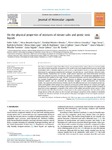On the Physical Properties of Mixtures of Nitrate Salts and Protic Ionic Liquids

Ver/
Use este enlace para citar
http://hdl.handle.net/2183/30601
A non ser que se indique outra cousa, a licenza do ítem descríbese como Atribución-NoComercial-SinDerivadas 4.0 Internacional
Coleccións
- Investigación (FCIE) [1259]
Metadatos
Mostrar o rexistro completo do ítemTítulo
On the Physical Properties of Mixtures of Nitrate Salts and Protic Ionic LiquidsAutor(es)
Data
2022-01-19Cita bibliográfica
Vallet, P., Bouzón-Capelo, S., Méndez-Morales, T., Gómez-González, V., Arosa, Y., de la Fuente, R., López-Lago, E., Rodríguez, J.R., Gallego, L.J., Parajó, J.J., Salgado, J., Turmine, M., Segade, L., Cabeza, O., Varela, L.M., 2022. On the physical properties of mixtures of nitrate salts and protic ionic liquids. Journal of Molecular Liquids 350, 118483. https://doi.org/10.1016/j.molliq.2022.118483
Resumo
[Abstract] We report a systematic study of the effect of salt concentration and its cation valence on several equilibrium and transport properties of mixtures of the model protic ionic liquid ethylammonium nitrate with monovalent (LiNO3), divalent (Mg(NO3)2 and Ca(NO3)2), and trivalent (Al(NO3)3) salts. These properties, determined by appropriate experimental techniques, include density, sound velocity, refractive index, surface tension, conductivity and viscosity. Single-particle dynamics and radial distribution functions were also analyzed by means of molecular dynamics simulations. The temperature dependence of the conductivity was studied in the Vogel-Fulcher-Tammann framework, and we obtained effective activation energies, fragility indexes, and Vogel temperatures. In addition, we performed a high-temperature Arrhenius analysis and we calculated the activation energies of both conductivity and viscosity. Finally, the exponents of the fractional Walden rule for the different mixtures were obtained and the ionicities and fragilities of the systems were analyzed, proving that all the mixtures are subionic and fragile. The distortion of the network of hydrogen bonds characteristic of protic ionic liquids and the formation of long-lived anionic aggregates composed of the cations of the added salt and the nitrate anions in their first solvation shell were found to have a deep impact on the analyzed properties. The role of the surface charge density of the salt cations on the structure and transport properties of the solutions is detailedly analyzed and related to solvation of salt species in the polar nanoregions of the ionic liquid (nanostructured solvation).
Palabras chave
Protic ionic liquids
Inorganic salts
Mixtures
Physicochemical properties
Optical properties
MD simulations
Inorganic salts
Mixtures
Physicochemical properties
Optical properties
MD simulations
Versión do editor
Dereitos
Atribución-NoComercial-SinDerivadas 4.0 Internacional
ISSN
0167-7322






